The Ultimate Size Guide For Trampolines – Which One Is Right For You?
Trampoline comes in a lot of different shapes and sizes. And while some might see this as a good thing as it offers a lot of choices – to some, it might make things complicated. New buyers, for instance, won’t know which size or shape is right for them.
Now if you decide to just “wing it” and go with the biggest size you can for your budget – there’s another problem that you’ll have to deal with. Bigger trampolines typically offer a better bounce which for beginners or younger jumpers can be pretty difficult to handle.
So, what’s the right choice here? Which trampoline size would be perfect for your backyard?
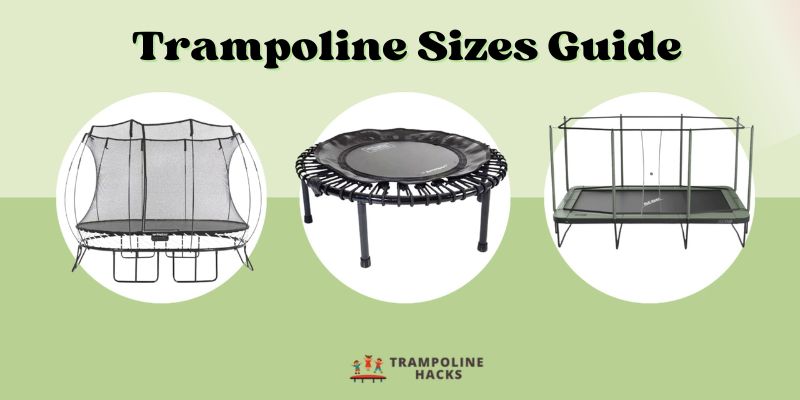
Well, there are a lot of things to consider, such as the jumper’s skill and age, the size of the backyard, your budget, etc. And you also need to know how many size options you have in the first place.
check Best 10ft Trampolines
There’s a lot to cover here, and if you have little to no experience with a trampoline, I’m sure you’re feeling overwhelmed by now. But don’t worry – I’ve got your back.
In this article, I will give you a thorough size guide for trampolines so that you’ll have a complete picture of your size options and can easily figure out which trampoline size is perfect for your own backyard. So, let’s hop in.
Does the Size Matter in a Trampoline?
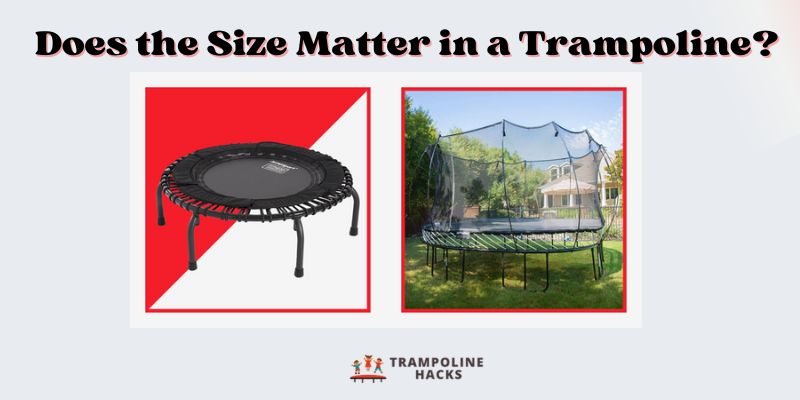
Before I take you further down the rabbit hole – I’m sure many of you are wondering whether the size even matters in a trampoline. As long as it can fit everyone, you should be fine, right?
Well – no, there’s more to it than that.
You see, the size tells you a lot of things about the trampoline. For instance, a large 16-foot trampoline isn’t designed for younger kids or solo jumpers but instead for two or more people who are at least 14 years of age or older.
With a larger trampoline, you will have a larger jumping space, sure, but the jump distance will also be higher. Needless to say, if you put an inexperienced jumper on a truly premium, big trampoline, he will struggle to control his momentum. That can, in turn, lead to accidents.
Check Best 16ft Trampolines.
As you can see, size plays a huge role in dictating your overall experience with the trampoline. If you don’t pick a trampoline size that’s not suitable for you and your jumping skill, you might not have too much of a good time with it.
Average Trampoline Sizes and Targeted Users
Not all trampolines are suitable for people of all ages. For instance, a trampoline that a gymnast would use to pull off different aerial tricks isn’t the same size or design as the one that you would let your kids jump on. A young kid under ten years old will require a much smaller trampoline with safety as its priority.
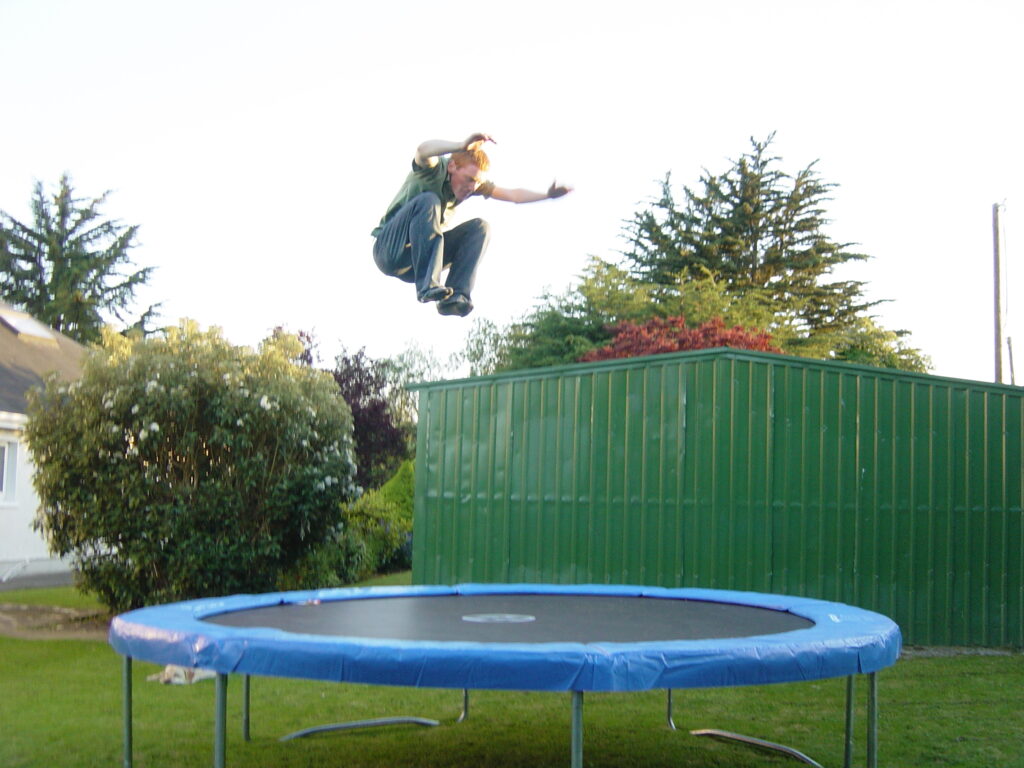
And that’s why manufacturers design trampolines in all these sizes – to ensure that people of all ages have the option to try out trampolines that suit their skill level. Besides, budget and space constraints also play a role in determining the perfect trampoline size for you, but we’ll get to that later.
For now, let me give you a quick chart highlighting different trampoline sizes and the age groups they are most suited for –
| Age Group | Trampoline Size | Indoor/Outdoor |
| Adult (Gymnasts) | 17 Feet Trampoline or Bigger | Outdoor |
| Adult (Fitness) | Mini Trampoline | Indoor |
| 14 – 16 Years Old | 12 to 16 Feet Trampoline | Outdoor |
| 11 – 13 Years Old | 10 to 14 Feet Trampoline | Outdoor |
| 10 Years Old | 10 to 12 Feet Trampoline | Outdoor |
| 7 – 9 Years Old | 8 to 12 Feet Trampoline | Outdoor |
| 5 – 6 Years Old | 6 to 10 Feet Trampoline | Outdoor |
| 4 Years Old | Mini Trampoline or Under 6 Feet Trampolines | Indoor/Outdoor |
| 1 to 3 Years Old | Mini Trampoline or Toddler Trampolines | Indoor |
From the above chart, you can get a general idea of the size range for different age groups. Not all trampolines are outdoor, though. There are some mini trampolines (also known as rebounders) that you could buy if you want to set up your trampoline indoors. These trampolines are designed mostly for fitness enthusiasts.
Check best 15ft trampolines
You also need to take into account the shape of the trampoline. Trampolines are available in four shapes – rectangle, square, oval, and round. For homeowners, the most common size is round. But for people with large families, a rectangle or a square trampoline is also a great option.
To learn more about the differences between a rectangular and round trampoline, you can check out my article here. Now that you have a general idea about your options let me break down how the size of the trampoline can affect your experience with it.
Trampoline Sizes for Toddlers and Younger Kids
When you’re buying a trampoline for a toddler or younger kids under 12 years old, safety is your first priority. So, you don’t want to go with a big trampoline that offers a massive bounce per jump. A smaller trampoline with a stronger frame, better safety features, and a smaller number of springs is usually the better choice for kids.
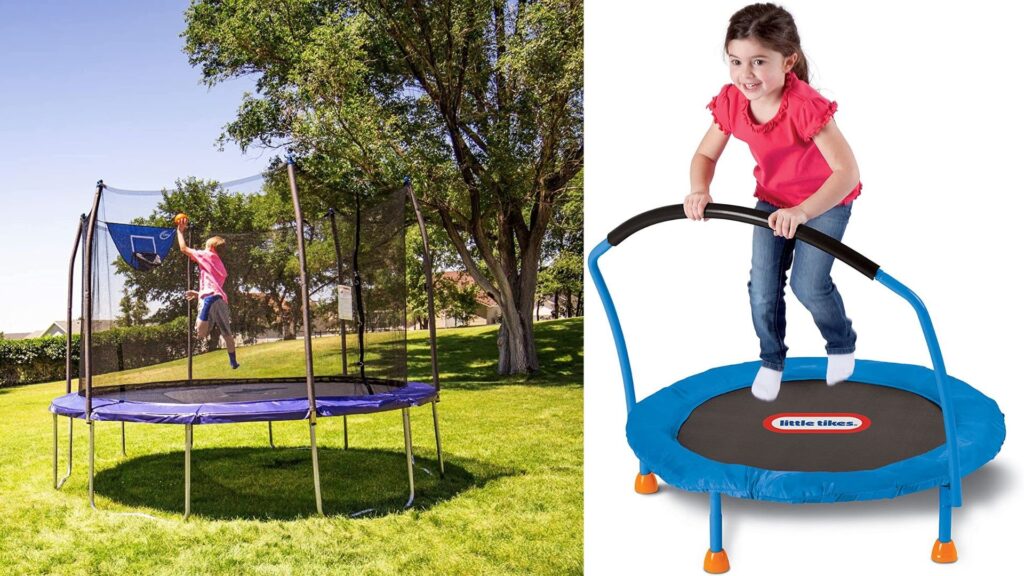
For toddlers and kids under 12, here are your size options when choosing a trampoline –
| Age Groups | Trampoline Size | Indoor/Outdoor |
| Toddler (1- 3 Years Old) | Mini Trampoline or Toddler Trampoline | Indoor |
| 4 – 6 Years Old | 6 – 8 Feet trampolines | Outdoor |
| 7 – 9 Years Old | 8 – 10 Feet Trampolines | Outdoor |
| 10 – 12 Years Old | 10 – 12 Feet Trampolines | Outdoor |
For toddlers, you shouldn’t really consider picking up an outdoor trampoline. There are many toddler trampolines out there that you can set up in your kid’s room in a corner. These trampolines are usually made out of cushions and allow your little one to jump around inside without ever worrying about falling off.
But for kids over four years old, going with a larger trampoline is usually better. This will give them a bigger surface area to jump around in and also get them outside the house. For 4 to 6 years old, an 8 feet trampoline is the biggest size you should go with.
Check Best 20 ft trampoline
For older kids, those between the age of 7 to 12, you have a bit more flexibility. You can go with up to 12 feet trampolines giving them the opportunity to jump around to their heart’s content. But then again, make sure you are monitoring them closely when they are jumping on the trampoline. You shouldn’t let your kids jump alone on a trampoline.
Trampoline Sizes for Teenagers
For teenagers, you can be a bit more flexible when picking out the size for your trampoline. And since teenagers have better reflexes, even if they lose their balance, they’ll be able to catch themselves before any accidents. Besides, there’s always the enclosure net around your trampoline to protect them.
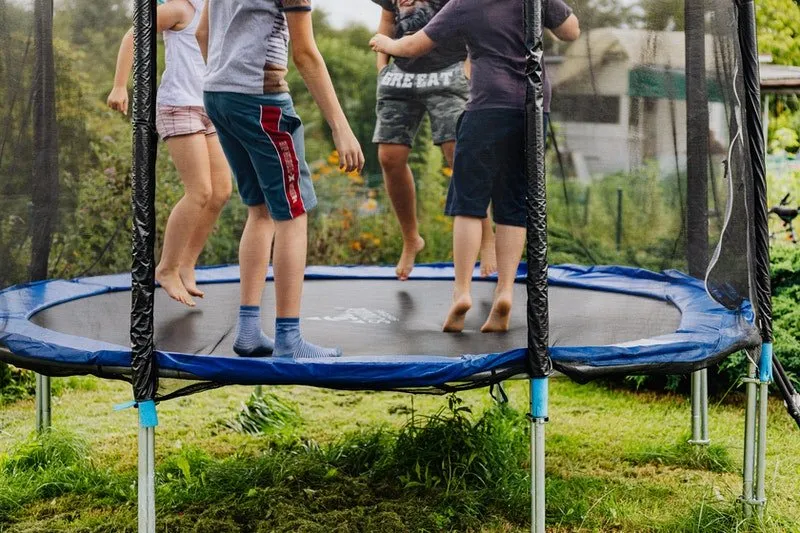
Here are the sizing options for teenagers when you’re buying a new trampoline –
| Age Groups | Trampoline Size | Indoor/Outdoor |
| 13 – 15 Years Old | 12 to 14 Feet Trampoline | Outdoor |
| 16 – 17 Years Old | 14 to 16 Feet Trampoline | Outdoor |
| 18 – 19 Years Old | 14 to 17 Feet Trampoline | Outdoor |
Teenagers mostly prefer using an outdoor trampoline. And while some fitness enthusiasts will prefer jumping on a rebounder for different trampoline exercises, it’s usually better to go with an outdoor model if you want to jump freely.
For younger teens, those between the age of 13 and 15, a 12 to 14 feet trampoline should suffice. It will give you a decent jumping experience, and you can also get a decent height with each jump.
For older teens, though, going with a smaller trampoline might not be that ideal. If multiple people are going to be using the trampoline, then it’s best to go with at least a 14 feet trampoline. Going for a high-quality gymnastic trampoline might not be a bad idea either.
Check Best 14ft trampolines
Trampoline Sizes for Adults
If you’re buying the trampoline so that you can jump on it with your family, then it’s usually better to go with a large trampoline. There are some benefits to going with a larger trampoline, the biggest one being that it gives you plenty of jumping area for everyone.

Here are the trampoline sizing options for adults –
| Age Groups | Trampoline Sizes | Indoor/Outdoor |
| Adult (solo) | 12 to 16 Feet Trampoline | Outdoor |
| Adult (Family) | 16 Feet or Bigger | Outdoor |
| Adult (Fitness) | Rebounder | Indoor |
As you can see, if you are jumping on it solo, then you don’t need to worry about all that. As long as it can handle your weight and has enough space to let you jump to your heart’s content, you’re free to go with any trampoline you like.
Check Best 12 ft trampoline
There are many fitness buffs who like to add some trampoline exercises to their workout routine. If you are one of them, it might be better to go for a rebounder instead of an outdoor trampoline. Rebounders can be put in your home, upstairs, or even in your basement without too much hassle.
Trampoline Sizes for Gymnasts
Gymnastic trampolines are not the same as traditional recreational models that you put in your backyard. The trampolines that professional gymnasts or acrobats use come in a specific dimension. In most cases, gymnasts use a high-quality rectangular trampoline that is 10 feet wide and 17 feet long.
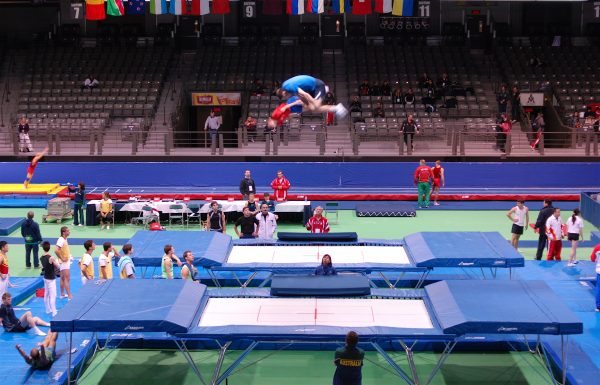
But of course, if you are a casual jumper and want to try your hand at learning some aerial tricks, then going with a trampoline over 17 feet should suffice. But I would strongly recommend going with either a rectangular or square model since round trampolines have a center-focused bounce. As a result, learning tricks can be difficult.
What to Consider When Choosing the Trampoline Size
Picking the correct size might be the most important part of buying a new trampoline. And by now, you should have a good grasp on what size of the trampoline is suitable for which users.
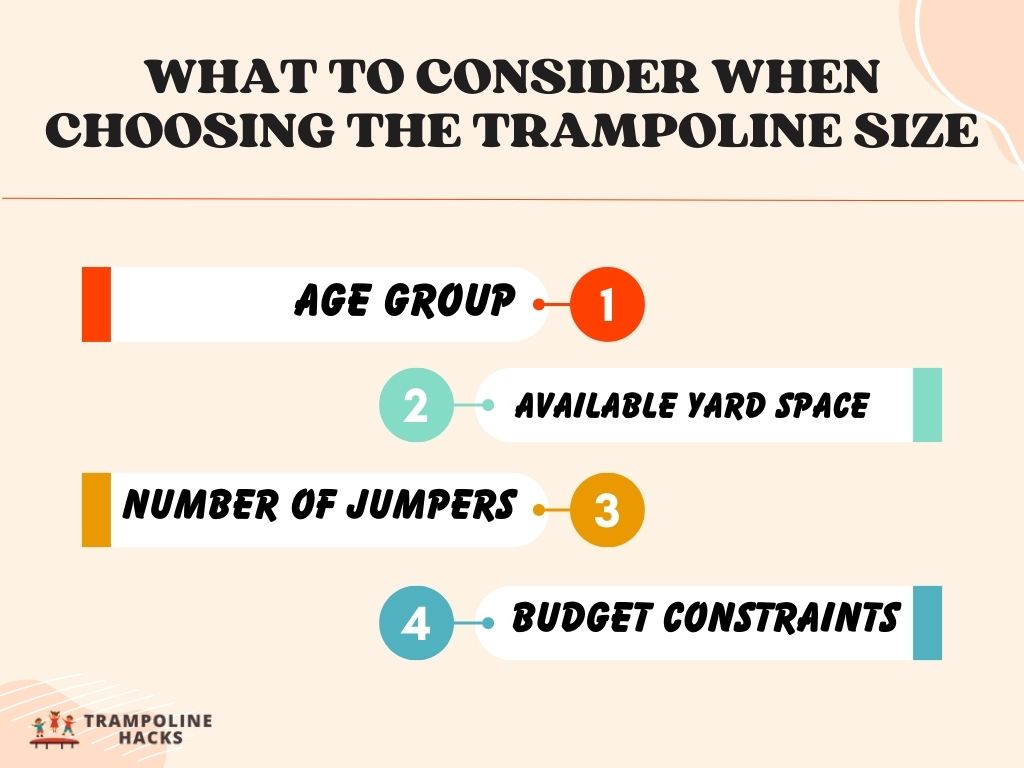
But if you’re still having a hard time, perhaps the following section will help you figure out which trampoline size you should go for your specific situation.
Age Group
The first thing to look at when you’re deciding on the size of a trampoline is the age group of the people that will be using it. For younger kids and teenagers, you usually want to stick to a smaller trampoline. But for adults or families, a larger trampoline is a better choice.
If the trampoline will be used by children under ten years old, it’s best to stick with a trampoline under 12 feet. For older kids or adults, I would recommend going with a 14 or 16 feet trampoline depending on how many people will be jumping on it at once. You also need to consider how much weight the trampoline can hold at a time.
Available Yard Space
One thing that many people overlook when buying a new trampoline is their available yard space. What ends up happening is that you go and get a trampoline, only to find out later that your backyard doesn’t have enough space for you to set it up. And your only option then is to send it back and get a smaller one.
So you should save yourself the hassle and measure out how much space you have for the trampoline in your backyard beforehand. Once you have a basic measurement of the available space, you can use that information to settle on a trampoline that you can install without any trouble.
Number of Jumpers
More jumpers mean more risk of bumping into one another while jumping. And to combat that issue, you need to invest in a bigger trampoline if you plan on letting more than one jumper use the trampoline at a time. I would also recommend going with either an oval or a rectangular trampoline for multiple jumpers.
For two or more jumpers, a 15 or 16 feet trampoline should be enough. But if you have a large family, then you might need to go with a bigger model. And inversely, if you plan on jumping on the trampoline solo, then you could probably get by with a smaller model.
Budget Constraints
Budget is, of course, a big factor when you’re choosing a trampoline. And while the price of a trampoline depends on things like the quality of the frame, the brand, and many other things – one of the biggest contributors to its price is its size. A bigger trampoline is usually more expensive than a smaller model.
The reason is that to manufacture a bigger trampoline, you need more materials which end up hiking the cost of the trampoline. So if you have the budget for it, then you can go with a trampoline of any size depending on your requirements. But if your budget is tight, a smaller trampoline is the better choice.
Frequently Asked Questions
Before I take my leave, let me address some of the questions that I often get asked by people about trampoline sizes –
Does the Height of a Trampoline Matter?
The height of a trampoline can mean two things – the distance from the ground to the jumping mat and the height of the enclosure net. And while the height of a trampoline doesn’t matter as much as the length and width of the trampoline, you should give it some thought.
If the jumping mat of the trampoline is too high from the ground, falling out of the trampoline can lead to serious injury. But you also don’t want it to be too low as it will interfere with the jumping mat when you’re bouncing on it.
As for the height of the enclosure, the higher the enclosure is, the better it is for you. Ideally, you should aim for enclosure nets that are at least 6 to 8 feet high.
Is a Bigger Trampoline Better?
Not necessarily. However, since bigger trampolines cost more, manufacturers tend to use better materials for its construction. Because of that, a bigger trampoline often features a better build quality.
How to measure the size of a trampoline?
The size of a trampoline refers to the distance between its two farthest points. That means, for a round trampoline, its size refers to its diameter. And for a rectangular trampoline, the size of a trampoline is measured in its length. So, if you’re going with a 14 feet rectangular trampoline, that means its length is 14 feet.
With Everything Said and Done
Picking up a new trampoline is never easy. And while you might think that the size of the trampoline is a pretty basic thing to consider – you’d be surprised how many people mess it up.
But now that you have a clearer picture of how the size of the trampoline affects its performance, you should be all set to focus on the other things.
I hope my in-depth guide on trampoline sizes could help you land the perfect trampoline for your backyard. Good luck!
Hi, It’s Jason and Louise here and welcome to our website. We are parents to Hannah and Zachary who absolutely love the outdoors and are actually addicted to jumping on their trampoline. Our amazing little family lives on a beautiful 20-hectare rural property with Horses, Dogs, Cats, Chooks, a Rooster, Cats and also a Pet Kangaroo.
